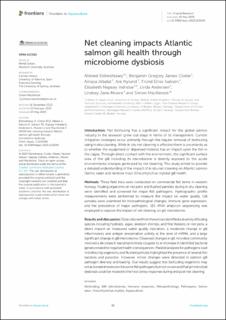| dc.contributor.author | Elsheshtawy, Ahmed | |
| dc.contributor.author | Clokie, Benjamin Gregory James | |
| dc.contributor.author | Albalat, Amaya | |
| dc.contributor.author | Nylund, Are | |
| dc.contributor.author | Isaksen, Trond Einar | |
| dc.contributor.author | Indrebø, Elisabeth Napsøy | |
| dc.contributor.author | Andersen, Linda | |
| dc.contributor.author | Moore, Lindsey | |
| dc.contributor.author | Mackenzie, Simon | |
| dc.date.accessioned | 2023-06-13T11:54:39Z | |
| dc.date.available | 2023-06-13T11:54:39Z | |
| dc.date.created | 2023-05-31T09:45:45Z | |
| dc.date.issued | 2023 | |
| dc.identifier.issn | 2813-5334 | |
| dc.identifier.uri | https://hdl.handle.net/11250/3071148 | |
| dc.description.abstract | Net biofouling has a significant impact for the global salmon industry in the seawater grow-out stage in terms of its management. Current mitigation strategies occur primarily through the regular removal of biofouling using in situ cleaning. While in situ net cleaning is effective there is uncertainty as to whether the equipment or dispersed material has an impact upon the fish in the cages. Through direct contact with the environment, the significant surface area of the gill including its microbiome is directly exposed to the acute environmental changes generated by net cleaning. This study aimed to provide a detailed understanding of the impact of in situ net cleaning on Atlantic salmon (Salmo salar) and rainbow trout (Oncorhynchus mykiss) gill health. Three field trials were conducted on commercial fish farms in western Norway. Fouling organisms on net pens and flushed particles during in situ cleaning were identified and screened for major fish pathogens. Hydrographic profile measurements were performed to measure the impact on water quality. Gill samples were examined for histopathological changes, immune gene expression, and the prevalence of major pathogens. 16S rRNA amplicon sequencing was employed to explore the impact of net cleaning on gill microbiome. Data obtained from these trials identified a diversity of fouling species including hydroids, algae, skeleton shrimps, and filter feeders on net pens, a direct impact on measured water quality indicators, a moderate change in gill inflammatory and antigen presentation activity at the level of mRNA, and a large significant change in gill microbiome. Observed changes in gill microbial community involved a decrease in bacterial richness coupled to an increase in identified bacterial genera related to negative health consequences. Parallel analyses for pathogens load in biofouling organisms and flushed particles highlighted the presence of several fish bacteria and parasites. However, minor changes were detected in salmon gill pathogen diversity and loading. Our results suggest that biofouling organisms may act as transient reservoirs for some fish pathogens but not viruses and that gill microbial dysbiosis could be related to the host stress response during and post net cleaning. | en_US |
| dc.language.iso | eng | en_US |
| dc.publisher | Frontiers | en_US |
| dc.rights | Navngivelse 4.0 Internasjonal | * |
| dc.rights.uri | http://creativecommons.org/licenses/by/4.0/deed.no | * |
| dc.title | Net cleaning impacts Atlantic salmon gill health through microbiome dysbiosis | en_US |
| dc.type | Journal article | en_US |
| dc.description.version | publishedVersion | en_US |
| dc.rights.holder | Copyright 2023 The Author(s) | en_US |
| dc.source.articlenumber | 1125595 | en_US |
| cristin.ispublished | true | |
| cristin.fulltext | original | |
| dc.identifier.doi | 10.3389/faquc.2023.1125595 | |
| dc.identifier.cristin | 2150356 | |
| dc.source.journal | Frontiers in Aquaculture | en_US |
| dc.relation.project | Fiskeri- og havbruksnæringens forskningsfinansiering: 901514 | en_US |
| dc.subject.nsi | VDP::Akvakultur: 922 | en_US |
| dc.subject.nsi | VDP::Aquaculture: 922 | en_US |
| dc.subject.nsi | VDP::Akvakultur: 922 | en_US |
| dc.subject.nsi | VDP::Aquaculture: 922 | en_US |
| dc.identifier.citation | Frontiers in Aquaculture. 2023, 2, 1125595. | en_US |
| dc.source.volume | 2 | en_US |

